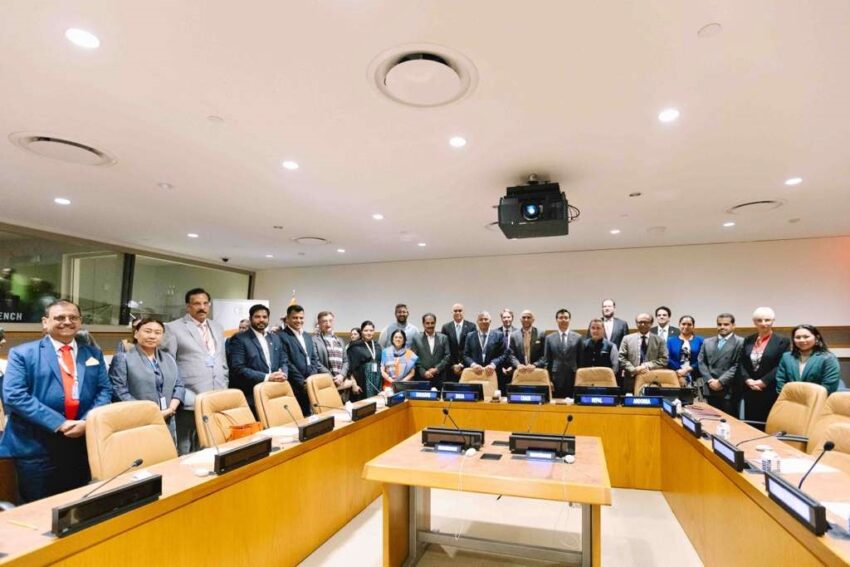
United Nations – The contribution of Bollywood Films to popularizing Hindi language and Indian culture was acknowledged by representatives of the member states of United Nations (UN) during the commemoration of Hindi Divas at the UN headquarters October 9, 2025.
Organized by the Permanent Mission of India to the UN, the event was attended by India’s member of parliament P.P. Chaudhary, India’s permanent representative to the UN P. Harish, Chief of the UN Communications Campaigns Service Nanette Braun, permanent representatives of Nepal, Andorra, Micronesia, Burundi, Mauritius, Guyana, Trinidad and Tobago and Suriname.
Hindi’s reach through Bollywood Films
Speakers acknowledged that their exposure to Hindi and its popularity in their countries had a lot to do with watching India’s Hindi cinema and dancing to its music.
Giving credit for Hindi’s popularity to Bollywood and to the global Indian Diaspora, Harish, said, “Hindi has become synonymous with the vibrant cultural landscape of India, and has transcended geographical boundaries to emerge as a popular language around the globe, on the strength of our diverse Diaspora as well as the prominence of Bollywood and literature”.
Chaudhary also spoke about the impact of Bollywood films in spreading Hindi to Russia, Egypt, Africa and Latin America. “People dance to Hindi tunes without even knowing the meaning. This is a magical power of Hindi,” he said.
The permanent representative of Andorra, Joan Forner Rovira, said he also has danced to Bollywood music although he does not speak Hindi.
Guyana’s deputy permanent representative Trishala Persaud said the love for Hindi in Guyana has been fostered through Bollywood films, music, and Indian television, which continue to capture the hearts of many in Guyana, as in Trinidad and Tobago and Suriname.
Trinidad’s permanent representative Neil Nadesh Parsan also spoke of Hindi’s spread through films and music. “It has transcended borders, connecting millions across the globe through literature, cinema… music, and everyday conversation,” he said.
Hindi’s spread through Social Media
At the same time, Hindi’s usage on Social Media has contributed to Hindi’s popularity and increased use, Chaudhary said. “Even in today’s digital age, Hindi continues to hold its global swing through social media, yoga and international education. Hindi is now a language of global communication,” Chaudhary said.
The Hindi at UN Project launched in 2018, uses Hindi for public outreach through social media, newsletters and a UN News website to connect with millions of Hindi-speaking people worldwide. This project has been extended for 5 more years, Harish informed.
Elaborating on the Hindi Project, Braun said, currently, the Hindi social media network boasts around 137,000 total followers, while accumulating over 3.7 million views across all channels in the past year. The UN Hindi news website has attracted approximately 346,000 views from 193,000 active followers, with a large portion of the audience between the ages of 18 and 34, Braun said. The UN has recently launched a Hindi WhatsApp channel, building on this, she informed.
Hindi’s reach abroad through Educational Institutes
A third way Hindi’s knowledge and use has extended to many countries is through educational institutes, Chaudhary said. He said well-known universities in the US and UK including Harvard, Columbia, Cornell, Chicago, Texas, Oxford and Cambridge, and in Stockholm offer degrees and courses in Hindi.
Mauritius’s permanent representative, Milan J.N. Meetarbhan noted Hindi’s integration into education in Mauritius since 1954 with various institutions including the Ramayan Center, the Hindi Prachar Sabha and The World Hindi Secretariat continuing to promote the language.
Other countries including Guyana, Suriname, Trinidad and Tobago and Nepal have local educational institutes offering education in Hindi at primary and secondary levels in schools, along with special courses in Hindi. Students from these countries also go to study Hindi in India.
Hindi: preserving cultural identity in multicultural societies
President of the Economic and Social Council and Permanent Representative of Nepal, Lok Bahadur Thapa said Hindi is among the top 20 languages spoken in Nepal. It is the mother tongue of nearly 100,000 people and at least 25,000 use Hindi as a secondary language in his multilingual and multicultural country.
Landry Sinomana, the representative of Burundi, shared his enriching experience of studying in India, learning Sanskrit and cooking Indian cuisine. Sinomana emphasized the significance of language in bridging gaps between nations and fostering international understanding.
Representatives from Trinidad and Tobago, Guyana and Suriname all spoke of Indian culture which their forefathers brought with them, along with Hindi language. Their cultural and religious identities have been preserved over the years, in religious practices, festival celebrations, and everyday conversations in Hindi language, the representatives asserted, Hindi thus having become identical with their cultural identities, even as more assimilation has been taking place.
Andorra’s representative discussed Andorra’s efforts at promoting multilingualism and cultural heritage in his country. Andorra has been co-facilitating a UN resolution on multilingualism for eight years. Rovira announced the launch of the Group of Friends on Multilingualism and invited all UN countries to join.
The event concluded with announcements of winners of Hindi essay and poetry writing and reciting competitions organized by the Permanent Mission of India and distribution of prizes.



